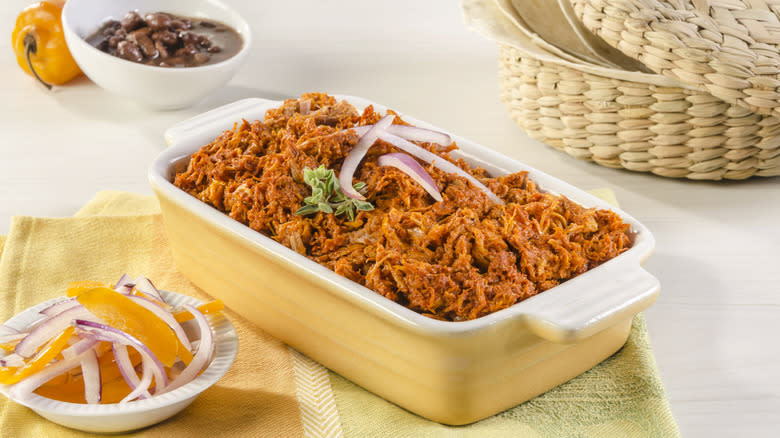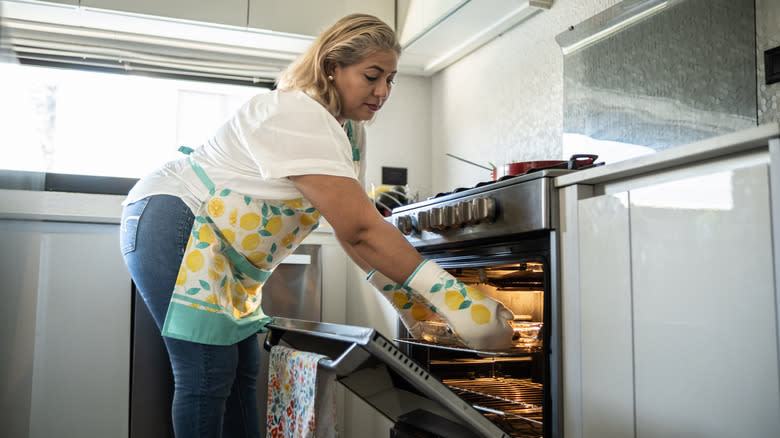The Best Way To Store Leftover Shredded Meat

Shredded, slow-cooked meat makes for the perfect sandwich or taco filling, ensuring a hearty and fulfilling meal. Larger cuts like chuck roast and pork shoulder work best for shredding, so you'll most likely have meat left over after cooking and will need to consider the best storage method to keep it tasty on subsequent days. In this case, you can retain the meat's moist texture in the refrigerator or freezer by incorporating cooking juices within the sealed container. The key is to ensure the shredded meat is sufficiently drenched in juices before putting it away.
Maintaining proper humidity levels is key to preventing food from prematurely spoiling while in cold storage. However, this lack of humidity can also have a detrimental effect on the quality of the food, namely by causing items to dry out and become less flavorful (think of produce in your crisper drawer). By storing leftover meat with its own juices in a sealed container, you can offset the lack of humidity and ensure the proper amount of moisture when you go to enjoy your leftovers on subsequent days.
Read more: The Unexpected Meat You Need To Avoid Grilling At All Costs
Storage Safety Guidelines For Leftovers

While adding succulent juices will keep meat nice and moist while being stored, you should also be aware of how long to store leftover meats. According to FoodSafety.gov, cooked poultry, such as chicken, and other types of meat, such as beef and pulled pork shoulder, can typically remain in the refrigerator for up to four days. As for freezing, leftovers should remain good from two to six months. Keep in mind that the longer you keep meat in the freezer, the more likely it is that you'll experience a decrease in flavor and texture. Also, these timelines are only applicable when the appliance is set to the correct temperature. Refrigerators should be at 40 degrees Fahrenheit or lower, while the freezer must be 0 degrees Fahrenheit or colder.
As for how to pack your leftovers for cold storage, the USDA offers some essential recommendations. Leftover meat must be placed in the refrigerator or freezer no later than two hours after being cooked, as leaving cooked food at room temperature can facilitate the growth of harmful bacteria. Additionally, use a container with a tightly sealing lid when prepping leftovers for storage. Otherwise, use plastic wrap or aluminum foil to create an airtight seal around food, then place it into the refrigerator or freezer immediately.
Tips For Reheating Shredded Meat After Cold Storage

While microwaves offer a convenient method for reheating leftover shredded meat like pulled pork, they aren't the best when it comes to maintaining quality. In this case, using the oven or a slow cooker will result in much tastier leftovers. You'll want to take the leftovers from the refrigerator or freezer and transfer them to a deep pan that's safe for use in the oven. If you still have some of the leftover juice reserved from when you made your dish, drizzle it over the meat. If you don't have any remaining juice, no worries, as you can use water, stock, or barbecue sauce in its place.
To keep everything moist, make sure to cover the top with a lid or a sheet of aluminum foil before placing the pan into your preheated oven. Higher heat will dry your meat out, so keep the temperature at around 225 degrees Fahrenheit -- you only want to warm it, not cook it. In an oven, this can take around 30 minutes, while a slow cooker could take as long as three hours. You'll know it's ready when it reaches 165 degrees Fahrenheit, which you can determine by using a meat thermometer. Even though it is already cooked, leftover meat should still be served at the proper temperature to further decrease the chance of foodborne illness. Now you can enjoy a delicious, shredded beef or chicken sandwich without sacrificing one iota of flavor.
Read the original article on Daily Meal.

